A quaint slow-paced quiet city, buildings with Baroque & Rococo architectures that were built during the 17th and 18th centuries, snow-capped Alpine range guarding the city borders, and magnificent vistas of nature… this is what Innsbruck greets you with.
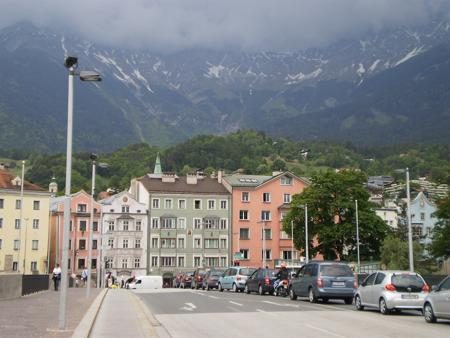
Stroll along the cobblestone walkways lined with pastel buildings and enjoy the wonderful views of the mountains all around, visit the historic museums, palaces and churches to explore the history of the once-powerful Habsburg dynasty, go up the mountains on a cable car to soak in panoramic views of the city and the Alps, and of course spend some leisure time at an outdoor cafe, have pastries and enjoy the city life.
And if you are looking for an active vacation, want to explore the steep alpine trails on mountain bikes, hike the scenic nature trails or love to ski down the snow strips with a range of difficulty grades, then there is perhaps no parallel to Innsbruck either.
Read: Great biking trails, bike rentals and guided tours in Innsbruck.
Innsbruck is the capital of the Austrian state Tyrol and is located on the Inn Valley. The name Innsbruck means Inn Bridge… the river Inn flows through the area and all the way to Switzerland and Germany. It became a major cultural and political centre of Europe in the 15th century… the Holy Emperor Maximilian-I of the Habsburg dynasty lived here.
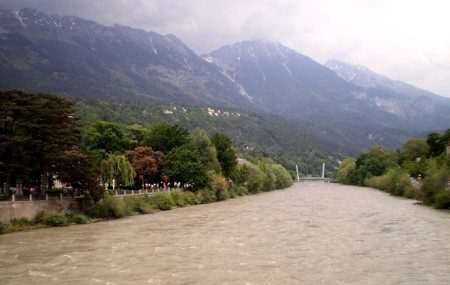
Since the beginning of 2000, a lot of face-lifting has taken place in the city… the main shopping street full of stores and cafes is Maria Theresien Strasse just outside the Old Town has been converted into a pedestrian zone offering a completely different experience. Several attractions have been added including the stunning cable car ride to Hafelekar – the top of Nordkette mountain. All these have transformed Innsbruck into a great travel destination today.
Watch this short video
Top Attractions
Start your day with a visit to Altstadt (the Old Town), free of vehicles, which was the power hub of the Habsburg monarchy. Visit the four-storeyed house where Emperor Maximilian-I once lived in the 1490s. It’s now a museum showcasing Coats of Arms, portraits of the Emperor and his two wives, and various other exhibits that capture the Emperor’s life and achievements.
However, the highlight of this 4-storeyed building is the Goldenes Dachl or the Golden Roof… a projected Royal Box on the top floor with a shining roof overlooking the square below. You can see the roof and the balcony standing at the Square. The roof was made with 2657 gilded copper tiles and shines like gold. This is where the emperor and his royal family would sit and watch jousting and festivals at the square below.
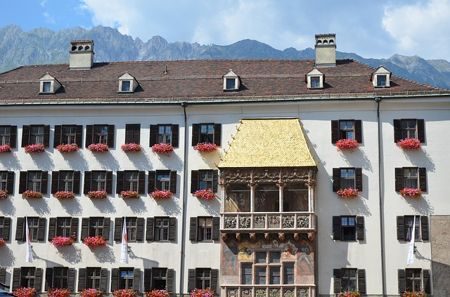
Hofburg in Old Town was the imperial palace of Emperor Maximilian-I and flaunts the power of the Habsburg kingdom. He expanded an existing building and it became the most beautiful building of the late Gothic period. However, it was later refurbished and renovated by Empress Maria Theresa in the 1750s transforming it into a Baroque palace.
This grand palace now has 25 staterooms and each creates an impressive mark with its unique grandeur and artwork. The 31-meter long Giant’s Hall with portraits of Maria’s children & grandchildren, exquisite paintings on the ceiling, candlelit chandeliers and fine artwork is a wonder by itself and so is the Guard Hall with its intricate wall murals that depict the battle scenes.
Another noteworthy attraction in the old town is the Hofkirche (the Court Church) which was built in the 1500s to house the tomb of Emperor Maximilian-I. The high tomb is decorated with the finest marble reliefs that portray the life scenes of the emperor. It’s surrounded by 28 larger-than-life bronze statues as the guard of honour and represented by his kins and role models including his two wives. However, the tomb itself is empty because Maximilian-I was buried in the chapel castle of Burg Wiener Neustadt near Vienna.
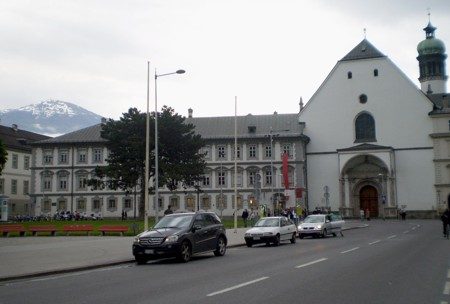
The Old Town has several other attractions. St. James Cathedral, also known as the Innsbruck Cathedral is a prominent Baroque style church that was built in the 1700s although reference to an existing church here goes back to as early as 1180. The divine sound of 57 bells ringing at noon would certainly draw your attention and so will the medieval fresco paintings on the church ceiling that depict the life scenes of St. James. However, the highlight here is the masterpiece painting ‘Maria Hilf’ by Lucas Cranach the Elder showing Madonna and her child.
From Goldenes Dachl walk south down Herzog Friedrich Street and get to the Stadtturm (City Tower), climb the 148 steps to reach the viewing platform at 31 meters and watch the town as the sentries did during the medieval period for over 450 years. Other than the bustling township and alleyways, you can see the Bergisel (the famous ski jumping tower), the River Inn and the Patscherkofel & Nordkette mountains.
Walk further down to Annasäule, a tall marble column made in 1702 with a statue of the Virgin Mary on top. The Triumphal Arch further down on Maria Theresien street is a victory arch made in 1765 by Empress Maria Theresa to celebrate her son’s wedding… it’s certainly worth a photo shoot.
Read: How to use the hop on hop off Sightseer bus to explore various attractions in Innsbruck.
Bergisel is the world’s one of the dramatic ski jumping towers and is located at the Isel mountain. This 50m high ski jumping facility was designed by architect Zaha Hadid and commissioned in 2002. There is a restaurant on top (Bergisel Sky) and a viewing platform which you can easily access using an elevator. View from there as you look down the hill and of Innsbruck city is simply breathtaking. Skiing started at Isel mountain way back in 1927 although Bergisel was built much later.
Schloss Ambras (or the Ambras Castle) is located at the outskirts of Innsbruck on top of a hillock and this magnificent building nestled in a sprawling park is visible from a distance. Archduke Ferdinand II expanded and converted a medieval castle in the 1500s into a Renaissance castle for his wife Philippine Welser.
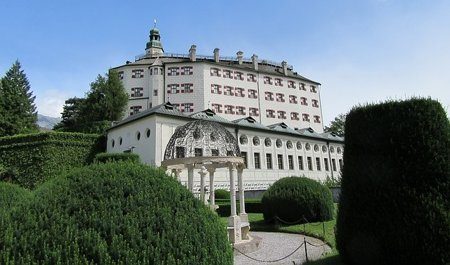
He also created a museum complex in front of the castle which is now the oldest museum in the world showcasing the cultural heritage of Europe. Welser’s residence, the Ambraser Hoch Schloss today houses Habsburg Portrait Gallery, Gothic sculptures and amazing glass collections. The 43-meter Spanish Hall with portraits of Tyrolean rulers was the largest hall of the 16th century. Archduke Ferdinand II brought in all his personal collections to the palace including weaponry, paintings, unusual nature collections, objects from foreign countries etc which are all exhibited.
Innsbruck Festival of Early Music is a well known annual event to music aficionados from all over the world. Music, opera and concerts by international singers, ensembles and orchestras take place at various venues in and around Innsbruck with a focus on Baroque Operas, Renaissance & Baroque music from medieval times to the early 1800s. Usually held in August, the sites for the event include the Spanish Hall in Ambras Castle, Treibhaus, the Tyrolean State Theatre and the Hofburg Imperial Palace among others.
Nordkettenbahn (Cable Car Ride at Nordkette Mountain) is perhaps the highlight of Innsbruck’s attractions. From the top (Hafelekar) you get a marvellous view of the glittering spires and domes of the city on one side, and Austria’s largest Nature Park (Karwendel) on the other. Take a funicular from Congress station right at the town centre up to Hungerburg. Along the way, the Alpine Zoo is a nice family attraction with bears, wild cats, eagles & birds in it.
From Hungerburg change to a cable car for Seegrube at an altitude of 6,250 ft. You can relax here at a restaurant and watch the vistas of snow-covered alpine peaks and nature around. The next cable car takes you further up to Hafelekar station (7,401 ft). The entire journey takes about 20 minutes. If you want, you can hike for another 15 minutes from Hafelekar station to reach up to the summit.
Who doesn’t know about Swarovski Crystals… but Swarovski Kristallwelten (Swarovski Crystal World) which is their original factory, an exhibition centre as well as a sales outlet is located at Wattens, only 20 km from Innsbruck. The dazzling show of countless crystal figurines, models, and jewellery are perhaps never seen anywhere else in the world. The galleries in Chambers of Wonders showcase the work from artisans all around the world. One of their latest additions is Crystal Cloud… hundreds of thousands of crystals appear to be floating in the air.
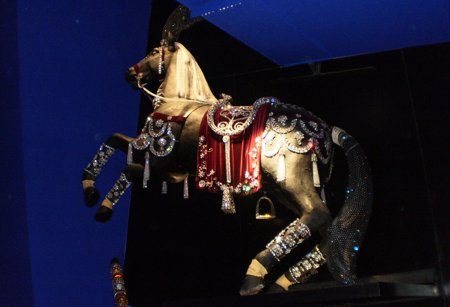
Well, you came to Innsbruck for the Alps, but having seen all the mausoleums and taken a glimpse of the Alpine range, you want to be in the Alps… and live a Nordic life with peace, relaxation yet being active… you should head off to the Alpine village Seefeld located on a plateau at an altitude of about 4,000ft and at a distance of 26 kms north-west of Innsbruck (takes only a 30-minute drive along highway A12 and then B177).
While you can not exactly replicate how the 3,500 odd natives live there, you can certainly stay there for a day or two, enjoy the breathtaking landscapes, hike or climb to your heart’s content, play 9 or 18-hole golf at one of the most beautiful courses in the Alps, do mountain biking or even e-biking, ski where the Olympians did in 1964 and 1976, swim at two of the most scenic lakes, outdoor pools or even heated indoor pools with your family or loved ones.
But there is a cost to pay for all this… a visit with a stay there would cost you anywhere between € 450 – 1,500 depending on the guided activities and type of hotel you choose. But if you are a budget traveller, you can still go there and spend some time on your own and not pay anything… that’s fine too, after all, it’s a village like any other without any entry bar. For a holiday package at Seefeld, visit this website.
Seefeld seems too far and out of affordable limits? Then visit Igls – another world of its own and located only 5 kms from Innsbruck. It’s a beautiful plateau nestled on Patscherkofel mountain of the Alps… a cable car can easily reach you there from May to October. Other than enjoying a panoramic view of Innsbruck city, you get sweeping views of Stubai, Wipptal and Inntal valleys from here.
And there are excellent activities here too… numerous scenic hiking trails, 9-hole golf course, walk up to the highest altitude garden in the alps or jump into the beautiful Lans lake for a swim. There is a kids park at the Patscherkofel valley cable car station… a nice place for families. From the Patscherkofel mountain station, you can walk to a small Baroque church that was built in 1662. There is a tavern and a spring with medicinal properties located next to the church.
And there are nice hotels in the lap of nature with magnificent views (rates from € 35 to 100 per person per night). For a holiday package at Igls, visit this website.
Read: Know about the top attractions in Innsbruck and how to visit them
Read: Know about the best self-guided and guided walking tours of Innsbruck.
Shopping
There are plenty of charming little shops at the Old Town centre of Innsbruck selling various souvenirs, gift & fashion items as well as local delicacies. Some of our favourite picks are traditional Tyrolean hats as well as funny-looking fridge magnets. The Old Town centre has a Swarovski Crystal outlet too.
The main shopping street is however just a few steps away from the Old Town… the Maria Theresien Strasse. Other than numerous street cafes, restaurants and boutique shops, you can get a modern shopping experience at the indoor Kaufhaus Tyrol and Rathauspassage shopping centres located here.
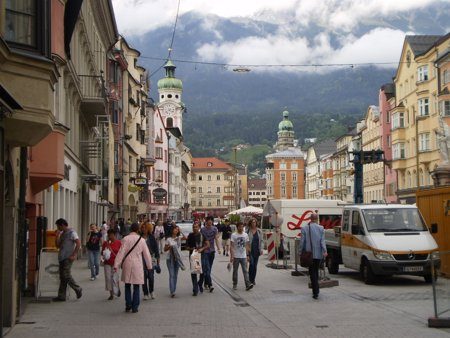
MPREIS is a supermarket chain to find great local produce and excellent wines. However, another small cute place to get the finest wine and spirits is Culinarium… a small bar with a shop at the Old Town. Here you can also savour some great wines served by the glass while munching on some local cheese and snacks.
If you are looking for some local sweets, walk over to Konditorei Munding located at the centre of the town… try out their ‘Golden Roof Tiles’ sweet delights. For chocolates head over to Konditorei Pichler and Arko located under the arcades. Another must-buy is the famous “Sachertorte” chocolate cakes. You can get them at Cafe Sacher located next to the Imperial Palace.
Food & Drinks
You must try some of the traditional Tyrolean food in Innsbruck that would leave a lasting savoury sensation and you would long to go for it again. If you love cheese, then you are at the right place because the dairy produce of alpine cows of Innsbruck is one of the best in the world.
Try out the simple dish Marend… a mix of smoked meat and sausages and served with slices of alpine cheese and bread. Another one is Kasspatzen… noodles baked in cheese and served with fried onions. Love more cheese and carb? Then an absolute must-try is Kaspressknödel, a form of fried flat dumplings made with potatoes and cheese, and served in a warm broth.
However, there is much more than cheese-based cuisine. The delicious Speckknödel is a dumpling made of bread, filled with bacon and usually served in a broth. For a simple sumptuous lunch, go for Gröstl, a mix of diced potatoes, onions and bacon all fried together and topped with fried eggs. Finish your meal with Apfel Knödel… basically, flat deep-fried & sweetened apple dumplings served with ice creams.
There are several cosy restaurants in and around the city centre where you can enjoy these authentic Tyrolean cuisines, one such place is Riese Haymon with a nice beer garden and serving a range of Tyrolean food. Another great place to try authentic Tyrolean food with traditional hospitality is Gasthaus Goldenes Dachl located right at the Old Town. Lichtblick located on top of Rathausgalerien shopping mall is not only famous for its 360-degree view, but it also serves a delectable blend of Austrian, Mediterranean and Asian cuisine.
The city also has a number of restaurants & eateries serving Asian food including Indian, Thai, Chinese and even Nepalese. For excellent Burritos, head for Machete… a little bar & restaurant. The burritos are large and superb, accompany that with some fine cocktails or beer. And to get a stunning view, visit Bergisel Sky, the panoramic cafe on top of the Bergisel Ski Jump (there are two elevators serving the cafe).
Nightlife
Although Innsbruck might look like a sedate university city during the daytime, you can find hundreds of locals converging towards Maria Theresien street and the alleyways of the Old Town where there are a number of cafes, pubs and bars. Some of them (under the viaduct arches) remain open till the wee hours.
Stop by the Culinarium, a tiny bar with a shop in the old town that specialises in fruit liqueur and brandy. They have a snug wine cellar and a beer garden outside. Prices are inviting and local snack specialities are nice including the cheese blocks. Right next to Goldenes Dachl is Prometheus Cellar and Cafe… this is the oldest dance club in Innsbruck. It has two sections… a cafe, and a bar with a dance floor. Blue Chip Club is another popular dance club for party lovers, particularly university students.
Casino Innsbruck offers several gaming options like poker, blackjack, roulette as well as 84 slot machines. They also have dining options. 360 Degree is a wine bar located on the roof of Rathausgalerien shopping mall (adjacent to Lichtblick restaurant). The glass-covered bar offers a 360-degree view and great cocktails. Invinum is a simple wine bar specialising in Austrian wine… great value for money. You can also purchase bottles of fine Austrian wines.
Hotel Scene
Innsbruck caters to a large base of tourists with varied interests & affordability. There are great value-for-money hotels, resorts and even hostels at various price ranges that can suit the pockets of all travellers.
There are hotels & resorts nestled right in the Alps with stunning views and offering vacation packages that include excellent rooms and a whole host of customised activities like hiking, golfing, cycling, village tours, swimming at alpine lakes and more. And there are hotels of all ranges within the city and the Old Town allowing visitors to explore the city attractions, historic sites, dining venues & nightlife easily.
One of the best in the luxury class is The Penz Hotel with a lovely rooftop terrace & bar. It’s located conveniently in the city with easy access to the shopping arcades. Another great mid-range/luxury hotel is Hotel Innsbruck, located centrally next to the river.
The mid-priced Best Western Hotel Goldener Adler is one of the oldest hotels of Europe preserved in its original historic form since 1390… excellent for city tourists and located steps away from ‘Golden Roof’ of Old Town. Run by a family the Basic Hotel is great for budget travellers and is located close to the Old Town. The rooms are clean, service is friendly and amenities are adequate including free wi-fi. Hotel choices in Innsbruck are literally countless.
Getting to Innsbruck
Innsbruck airport is located at the western end of the city at a distance of 4 km from the city centre. Being a regional airport, it has flight connections to a number of domestic and international destinations such as Vienna, London, Frankfurt, Amsterdam, Birmingham, Bristol, Edinburgh etc. The major airlines that operate to Innsbruck include British Airways, Austrian Airlines, Lufthansa, Finnair, EasyJet, Flybe, TUI Airways, Transavia, etc.
The train is a scenic, inexpensive and convenient way to get to and out of Innsbruck. The main railway station of Innsbruck (Hauptbahnhof Innsbruck) is connected to many domestic destinations as well as European capitals. Austrian destinations include Vienna, Salzburg, Linz, Graz etc. You can purchase tickets online from OBB (National Railway Company) website.
The OBB SparSchiene railway tickets are excellent value buys (starting from €19) to connect to several international destinations like Berlin, Prague, Hamburg, Dusseldorf, Zurich and more. Innsbruck station is well equipped with amenities such as lockers, supermarkets, cafes & bakeries, tobacconists, ATMs etc.
You can also use the long-distance FlixBus service to reach Innsbruck from almost all over Europe. These buses stop at Südbahnstraße street in Innsbruck. You can easily purchase tickets online through their website or using the mobile app.
Due to the wonderful and scenic road network, it’s always a pleasure to drive down to Innsbruck from several places within or outside Austria. From Vienna (to the east) there are several routes to Innsbruck… most pass through Salzburg. One of the shortest routes is via highway A1 (has tolls) which takes around 5 hours over a distance of 477 kms. From the west (e.g. Zurich or Lichtenstein) a good route to take is A12 (tolls apply for Arlberg Tunnel).
Getting Around
The Public Transport Authority of Innsbruck (IVB) operates city buses and trams. There are numerous bus routes within the city. While trams are not available late at night, several night liner buses are operated (in some parts of the city) all through the night. While you can buy single tickets from the bus driver, purchasing 24-hour or 5-trip tickets from the machines or IVB Service Centres would be cheaper.
Two tram lines operate within Innsbruck city (#1 and 3). There are two other tram lines that serve the surrounding areas and offer wonderful scenic routes to enjoy. Tramline #6 starts from Bergisel tram stop (where tram line #1 ends), passes through forests, goes south towards alpine plateau and ends at the Igls district. This line has been operational since 1900 and is locally known as the ‘Forest Tram’.
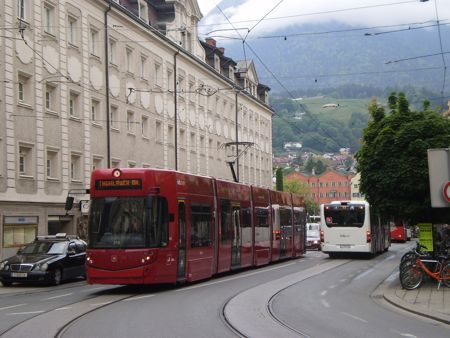
However the tram line STB offers the most scenic ride of all… it passes by lovely flowering meadow, imposing mountains, over the bridges with breathtaking views and though picturesque villages taking about an hour to reach Fulpmes in the Stubai Valley. Just sit back, relax and enjoy the ride and wonderful views.
VVT (Verkehrsverbund Tirol) operates both buses and trains to surrounding villages and areas of Innsbruck. There are numerous taxis in Innsbruck and you can call them over the phone or get them at the stands including at the airport. You can also rent a car at the airport or from one of the several rental companies. There are many bike paths in Innsbruck and you can easily rent a bike too and get around the city.
Funicular service is available from the city centre (Congress station) up to the Hamburger area. From there you can take the cable car to go up the Nordkette mountain to Hafelekar.
Note that it could be a great idea to purchase an Innsbruck Card (available for 24, 48 or 72 hours) which entitles you to free entry to numerous museums & attractions, and free rides in IVB operated buses & trams, as well as in cable cars & funiculars (including ones for Nordkette mountain) and hop-on-hop-off buses.
Read: How to get around Innsbruck easily on local transport
When to visit
Since Innsbruck is located almost at the centre of Europe and surrounded by the Alps, it sees a lot of temperature variation over the year compared to the other destinations in central Europe. Summers can be really warm and winters much cooler and snowy.
Summer (June to August) is the high tourist season… a great time for nature hikes, taking a dip into the lakes for a refreshing swim, city & sightseeing tours… Innsbruck bustles with tourists during this time and hotel rates soar. However there can be rains at times, so carry an umbrella or a raincoat.
Autumn (September to November) is when daytime starts shrinking and leaves change colours to orange & yellow, cattle return from the Alpine pastures, and nature turns to its most picturesque form. This is a great time in Innsbruck for musical events and savouring local delicacies.
The period December to February turns the city and its surrounding areas into a winter wonderland with a white blanket of snow. This is the time for winter sports… you can see hundreds of skiers at the winter resorts.
Spring (March to May) is when the temperature starts climbing again to comfortable levels. Snow starts melting and the meadows get covered with colourful crocuses. This too is a great time to visit Innsbruck when the tourist rush hasn’t started, hotel rates are low and the weather is perfect.
Read: Important weather conditions in Innsbruck and other major cities of Austria
 A travel addict. Still celebrating the day when he quit his high-profile corporate job to pursue his passion for travel writing.
A travel addict. Still celebrating the day when he quit his high-profile corporate job to pursue his passion for travel writing.